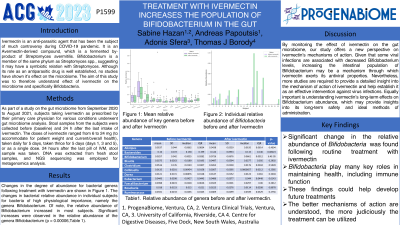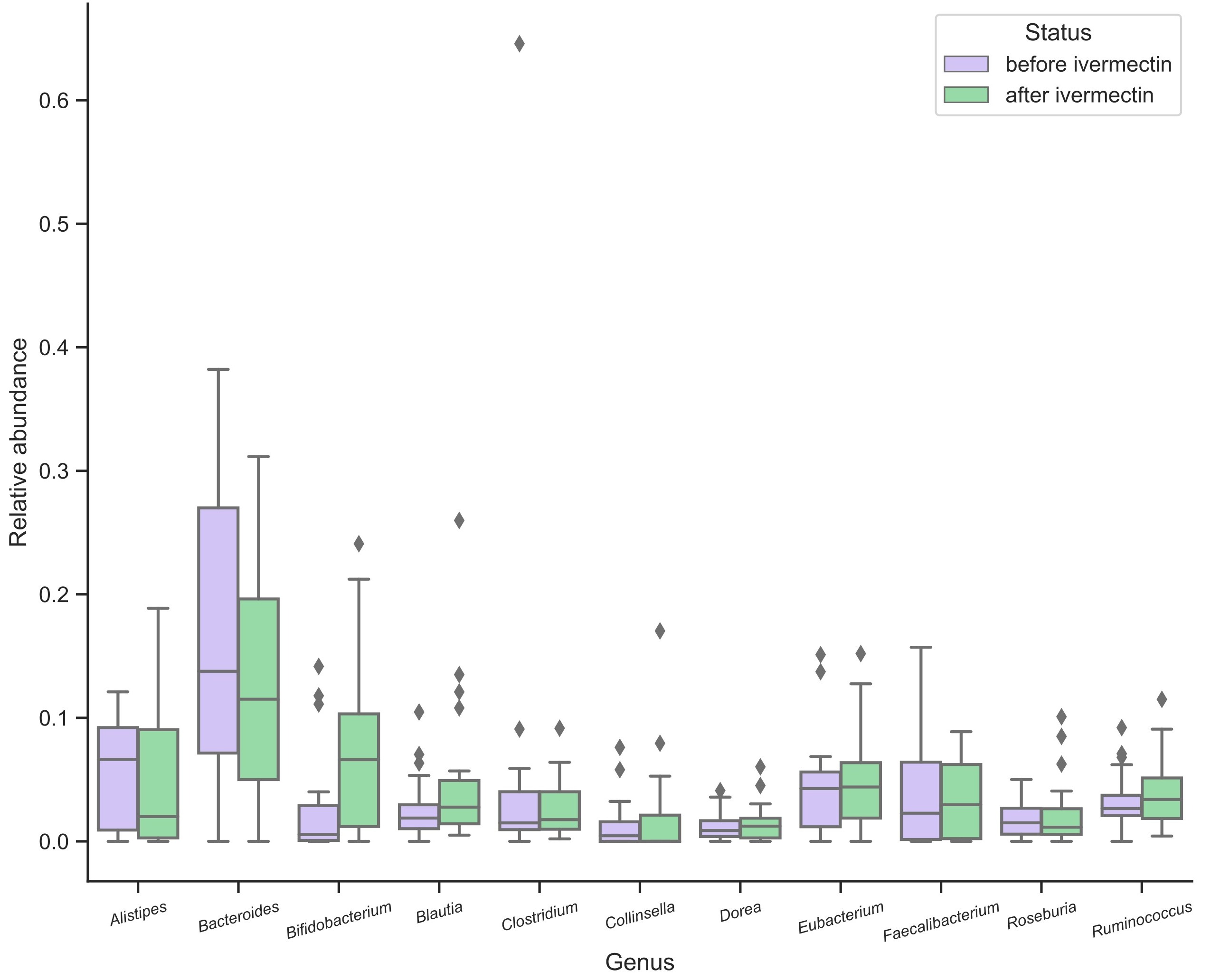Monday Poster Session
Category: Colon
P1599 - Treatment with Ivermectin Increases the Population of Bifidobacterium in the Gut
Monday, October 23, 2023
10:30 AM - 4:15 PM PT
Location: Exhibit Hall

Has Audio

Sabine Hazan, MD
ProgenaBiome
Ventura, California
Presenting Author(s)
Sabine Hazan, MD1, Andreas Papousis, PhD1, Adonis Sfera, MD2, Thomas Julius. Borody, MD, PhD, DSc, FACG3
1ProgenaBiome, Ventura, CA; 2University of Southern California Riverside, Riverside, CA; 3Centre for Digestive Diseases, Five Dock, New South Wales, Australia
Introduction: Ivermectin is an anti-parasitic agent that has been the subject of much controversy during COVID-19 pandemic. It is an Avermectin-derived compound, which is a fermented by-product of Streptomyces avermitilis. Bifidobacterium is a member of the same phylum as Streptomyces spp., suggesting it may have a symbiotic relation with Streptomyces.
Although its role as an antiparasitic drug is well established, no studies have shown it’s effect on the microbiome. The aim of this study was to therefore understand effect of ivermectin on the microbiome and specifically Bifidobacteria.
Methods: As part of a study on the gut microbiome from September 2020 to August 2021, subjects taking ivermectin as prescribed by their primary care physician for various conditions underwent gut microbiome analysis. Stool samples from the subjects were collected before (baseline) and 24 h after the last intake of ivermectin. The doses of ivermectin ranged from 6 to 24 mg (to accommodate for patient weight and current/overall health), taken daily for 5 days, taken thrice for 5 days (days 1, 3 and 5), or as a single dose. 24 hours after the last pill of IVM, stool sample was taken. DNA was extracted from fresh stool samples, and NGS sequencing was employed for metagenomics analysis.
Results: Changes in the degree of abundance for bacterial genera following treatment with ivermectin are shown in Figure 1. The changes in bacterial relative abundance in individual subjects for bacteria of high physiological importance, namely the genera Bifidobacterium. Of note, the relative abundance of Bifidobacterium increased in most subjects. Significant increases were observed in the relative abundance of the genera Bifidobacterium (p = 0.00006,Table 1).
Discussion: By monitoring the effect of ivermectin on the gut microbiome, our study offers a new perspective on ivermectin’s mechanisms of action. Given that some viral infections are associated with decreased Bifidobacterium levels, increasing the intestinal population of Bifidobacterium may be a mechanism through which ivermectin exerts its antiviral properties. Nevertheless, more studies are required to provide a detailed insight into the mechanism of action of ivermectin and help establish it as an effective intervention against virus infections. Equally important is understanding ivermectin’s long-term effects on Bifidobacterium abundance, which may provide insights into its long-term safety and ideal methods of administration.

Disclosures:
Sabine Hazan, MD1, Andreas Papousis, PhD1, Adonis Sfera, MD2, Thomas Julius. Borody, MD, PhD, DSc, FACG3. P1599 - Treatment with Ivermectin Increases the Population of Bifidobacterium in the Gut, ACG 2023 Annual Scientific Meeting Abstracts. Vancouver, BC, Canada: American College of Gastroenterology.
1ProgenaBiome, Ventura, CA; 2University of Southern California Riverside, Riverside, CA; 3Centre for Digestive Diseases, Five Dock, New South Wales, Australia
Introduction: Ivermectin is an anti-parasitic agent that has been the subject of much controversy during COVID-19 pandemic. It is an Avermectin-derived compound, which is a fermented by-product of Streptomyces avermitilis. Bifidobacterium is a member of the same phylum as Streptomyces spp., suggesting it may have a symbiotic relation with Streptomyces.
Although its role as an antiparasitic drug is well established, no studies have shown it’s effect on the microbiome. The aim of this study was to therefore understand effect of ivermectin on the microbiome and specifically Bifidobacteria.
Methods: As part of a study on the gut microbiome from September 2020 to August 2021, subjects taking ivermectin as prescribed by their primary care physician for various conditions underwent gut microbiome analysis. Stool samples from the subjects were collected before (baseline) and 24 h after the last intake of ivermectin. The doses of ivermectin ranged from 6 to 24 mg (to accommodate for patient weight and current/overall health), taken daily for 5 days, taken thrice for 5 days (days 1, 3 and 5), or as a single dose. 24 hours after the last pill of IVM, stool sample was taken. DNA was extracted from fresh stool samples, and NGS sequencing was employed for metagenomics analysis.
Results: Changes in the degree of abundance for bacterial genera following treatment with ivermectin are shown in Figure 1. The changes in bacterial relative abundance in individual subjects for bacteria of high physiological importance, namely the genera Bifidobacterium. Of note, the relative abundance of Bifidobacterium increased in most subjects. Significant increases were observed in the relative abundance of the genera Bifidobacterium (p = 0.00006,Table 1).
Discussion: By monitoring the effect of ivermectin on the gut microbiome, our study offers a new perspective on ivermectin’s mechanisms of action. Given that some viral infections are associated with decreased Bifidobacterium levels, increasing the intestinal population of Bifidobacterium may be a mechanism through which ivermectin exerts its antiviral properties. Nevertheless, more studies are required to provide a detailed insight into the mechanism of action of ivermectin and help establish it as an effective intervention against virus infections. Equally important is understanding ivermectin’s long-term effects on Bifidobacterium abundance, which may provide insights into its long-term safety and ideal methods of administration.

Figure: Figure 1. Relative abundance of various genera before and after ivermectin. Individual points correspond to individual subjects (n = 22), and before versus after ivermectin points are connected.
Disclosures:
Sabine Hazan indicated no relevant financial relationships.
Andreas Papousis indicated no relevant financial relationships.
Adonis Sfera indicated no relevant financial relationships.
Thomas Borody indicated no relevant financial relationships.
Sabine Hazan, MD1, Andreas Papousis, PhD1, Adonis Sfera, MD2, Thomas Julius. Borody, MD, PhD, DSc, FACG3. P1599 - Treatment with Ivermectin Increases the Population of Bifidobacterium in the Gut, ACG 2023 Annual Scientific Meeting Abstracts. Vancouver, BC, Canada: American College of Gastroenterology.
